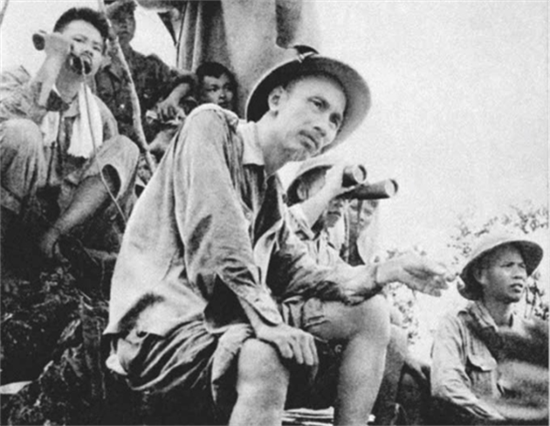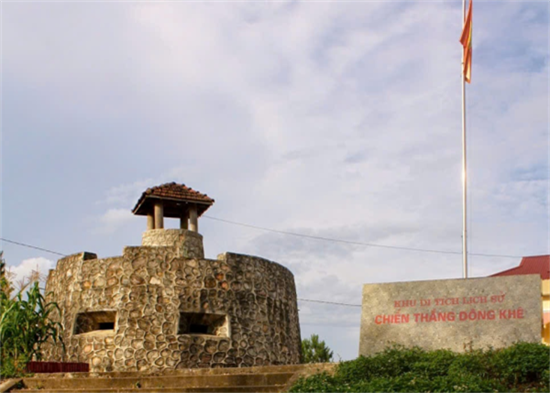75 years ago, under the leadership of the Party Central Committee and President Ho Chi Minh, our armed forces and people launched the Border Campaign - the first large-scale combined-arms offensive campaign of the Vietnam People’s Army (VPA) - and achieved a resounding victory. The success of the Campaign not only affirmed our VPA’s growing strength, but also marked a breakthrough in the art of offensive operations during the resistance war against French colonialism.
After suffering a heavy defeat in the Viet Bac Autumn Winter Campaign of 1947, the French colonialists’ strategy of “rapid strike, swift victory” was completely shattered. To salvage the situation and continue the war, the enemy strove to consolidate the East - West corridor, expand their occupation zone across the Northern midlands and the Red River Delta, and reinforce their North-East defensive line in an attempt to “seal off the border and strangle our resistance forces”. To carry out this plan, the enemy concentrated significant manpower, weaponry, and equipment and built key strongpoints along Route 4 at Cao Bang, Dong Khe, That Khe, Na Sam, and Lang Son. However, because their forces were dispersed across a wide and extended area, they had to face an increasingly serious dilemma of force distribution: concentration versus dispersion. As a result, their defensive posture lacked cohesion, exposing many vulnerable points.
 |
| President Ho Chi Minh directly commanded and encouraged troops during the Border Campaign of 1950 (file photo) |
Assessing the enemy’s strengths and weaknesses accurately, the Party Central Committee decided to launch the Border Campaign, striking the enemy’s defensive line along Route 4 with the aim of annihilating a significant part of their manpower, expanding the Viet Bac base area, and opening the Sino - Vietnam border to receive support from fraternal socialist countries. Our forces participating in the Campaign included Division 308, Regiment 209, Regiment 174, two main battalions of the Viet Bac Inter-Zone (Battalions 426 and 428), Lang Son’s Battalion 888, four mountain artillery companies, five engineering companies, along with local troops, conscripted labourers, and guerrillas of Cao Bang and Lang Son provinces. With high determination and unique military art, after nearly a month of continuous offensives - beginning with victory at Dong Khe strongpoint and followed by successive crushing blows against the enemy at Coc Xa and Hill 477, wiping out two elite French mobile groups - our forces completely smashed the enemy’s defensive system along Route 4. This victory was of strategic significance, creating a turning point in the resistance war against the French colonialists, forcing the enemy to adopt a gradual passive stance while our forces moved into the stage of counter-offensive and offensive operations. Victory of the Campaign affirmed a qualitative leap in our VPA’s art of campaign operations in several key aspects as follows.
First, correctly identifying the primary area of operations. This represented an important turning point in the Vietnamese operational art during the resistance war against French colonialism. In earlier campaigns, our forces were still hesitant and largely reactive to the enemy’s strategy and operational plans (such as in the Viet Bac Autumn Winter Campaign of 1947); or although the primary area of operations was identified, it was not “accurate and appropriate”, failing to connect strategic, operational, and tactical activities effectively, thus leading to limited combat effectiveness (as in Cao - Bac - Lang, Lo River, and Le Hong Phong I Campaigns, etc.).
In the Border Campaign of 1950, we selected the section of Route 4 from Cao Bang town to That Khe as the main area of operations. This was a completely correct choice, reflecting the keen, creative, and strategic thinking of the Campaign’s Party Committee and Command. The section of Route 4 from Cao Bang to That Khe, about 70 kilometres in length, was a strategically vital area for both sides; only by smashing this defensive line could we fully open the “gateway” to fraternal socialist countries and break the enemy’s encirclement of Viet Bac base area from the North-East direction. Although the enemy’s forces in each strongpoint were strong, their overall defensive posture along the line was extremely “loose” and lacked cohesion, as it relied on a single road axis with an extended frontage but shallow depth. The strongpoints at Na Sam, That Khe, Dong Khe, and Cao Bang town were far apart, in difficult terrain with poor mobility; thus, when we secretly and unexpectedly massed our troops and firepower for offensive action and cut both their land routes and air bridge, their ability to reinforce and support one another was severely limited - this was the enemy’s “fatal weakness”. Moreover, the Campaign’s area of operations was close to our rear, which was highly advantageous for operational command; at the same time, it allowed us to mobilise considerable manpower and resources for the Campaign.
Thanks to the correct choice of the primary area of operations, we consistently maintained and utilised the initiative, causing constant confusions and forcing them to react passively; each battle created the conditions and opportunities for subsequent engagements to secure victory. Through the combined-arms strength of our forces, we swiftly crushed Dong Khe strongpoint and successively defeated two elite enemy mobile groups in Coc Xa area and at Hill 477, thereby achieving the objectives set for the Campaign.
 |
| Dong Khe Victory historical site, Cao Bang province (photo: baocaobang.vn) |
Second, concentrating overwhelming superiority in manpower and firepower to ensure success in the key opening battle of the Campaign. In earlier campaigns, such as the North-East, Cao - Bac - Lang, Lo River, and Thao River, we failed to create overwhelming superiority in manpower and firepower; as a result, enemy strongpoints could not be decisively destroyed, or if they were, it took a prolonged period and incurred heavy casualties (as at An Chau, Ban Trai, Pho Lu, Nghia Do). By contrast, in the Border Campaign of 1950, in the decisive opening battle at Dong Khe, we massed forces that far outnumbered the enemy. In this battle, we deployed two regiments and two infantry battalions (nine times the enemy infantry), along with 13 mountain guns and recoilless rifles; we launched multiple thrusts, continuously breaking into Dong Khe strongpoint from the north, north-east, and south-west. Although the enemy relied on strong fortifications and firepower and resisted fiercely, we had sufficient forces to effectively handle every situation, defeating all their tactics and securing victory. Our troops and people fought continuously for 52 hours, systematically smashing each resistance pocket deep within their defensive network, annihilating and capturing the entire enemy garrison. This created an operational breakthrough, triggered a chain reaction, and laid the ground and opportunity for subsequent decisive battles against the enemy outside their fortifications. Victory in the key opening battle of the Campaign constituted a clear development in the art of combat organisation and command, particularly in force disposition and employment. It provided a foundation for application in larger-scale campaigns, enabling strategic victories that would ultimately bring the war to an end. At the same time, it offered both theoretical and practical lessons for the development of our VPA’s operational art.
Third, flexibly, creatively applying the tactic of “striking a point, destroying the relief”, with a focus on annihilating the enemy outside their fortifications for higher combat performance. To fulfil the Campaign’s objective of “destroying a significant portion of the enemy’s manpower”, the Campaign Command undertook researches, conducted assessments, drew an accurate conclusion about the situation across the board, and then adopted the tactic of “striking a point, destroying the relief”, with the principal aim of defeating the enemy outside their fortifications (enemy relief, support and withdrawing formations). Accordingly, the Campaign’s Party Committee and Command considered and selected Dong Khe strongpoint as the “bait”. Initially, we had planned to make Cao Bang town the opening target of the Campaign; however, enemy defence here was comparatively strong, with 15 garrison positions held by two enemy battalions. An assault on Cao Bang would have confronted many technical and tactical difficulties - for example river crossing, fighting deep within the enemy defensive network with a wide frontage, and facing enemy paratroopers - while our forces at that time had limited combat experience. Moreover, Cao Bang was an isolated strongpoint at the terminus of Route 4, some 45 kilometres from Dong Khe; its destruction would have been unlikely to produce a decisive shock or a cascading reaction to drive the Campaign forward. By contrast, at Dong Khe, the enemy had only deployed two reinforced companies. Attacking Dong Khe allowed us to avoid the enemy’s strongest positions and strike the weakest “link” in their defensive line - a critical point in their system. This ensured a high probability of success for the key opening battle and achieved the aim of “triggering” the enemy. If Dong Khe were destroyed, the enemy’s strategic defensive line would be cut in two, Cao Bang town would be completely isolated, and the enemy would be forced to move forces and resources from That Khe to relieve it - thereby creating favourable conditions for us to manoeuvre, attack and destroy enemy units outside their fortifications. Selecting Dong Khe as the opening objective was, therefore, a crucial basis for implementing the tactic of “striking a point, destroying the relief” - a major development in our VPA’s operational art during the resistance against French colonialism. Had we selected an overly strong objective (Cao Bang), our units would have lacked the capabilities to destroy it; conversely, choosing a target that was too small would not have created the “triggering” effect, drawing large enemy relief forces into the open for us to destroy.
It can be affirmed that the choice of Dong Khe as the objective of the key opening battle created an operational breakthrough, triggered a chain reaction, and compelled the French to send their elite main force units from That Khe and rapidly relocate their troops from Cao Bang town to relieve this position. This provided a golden opportunity for Division 308, Regiment 209, and Regiment 174 to focus their efforts to destroy enemy troops in Coc Xa area and at Hill 477. The Campaign Command thoroughly studied the terrain of the main area of operations, established a sharp, flexible mobile offensive posture, organised and deployed infantry and firepower appropriately, and patiently awaited the enemy’s movement into the selected area. Once engaged, our forces surrounded, isolated, and completely destroyed each enemy contingent, achieving successive victories in the second and third decisive battles. The resounding victories in the mobile offensive at Coc Xa and Hill 477 confirmed a qualitative leap in our operational art during the resistance against the French. Prior to this, from 1948 to early 1950, our units still carried heavy traces of a “fortification assault” mindset, focusing mainly on destroying the enemy within their strongpoints, neglecting the destruction of enemy forces outside fortifications, and even failing to identify the need to attack relief, reinforcement, or retreating forces. There was insufficient integration between “striking a point” and “destroying the relief”, resulting in many missed opportunities to completely destroy enemy units and low combat performance.
Victory of the Border Campaign of 1950 opened a new phase in our resistance war against French colonialism. The leaps in the operational art demonstrated in this Campaign should continue to be studied, further developed, and applied flexibly, creatively in any potential war to defend the Fatherland in the future.
Col. TRINH TIEN THANH, PhD
Army Academy
